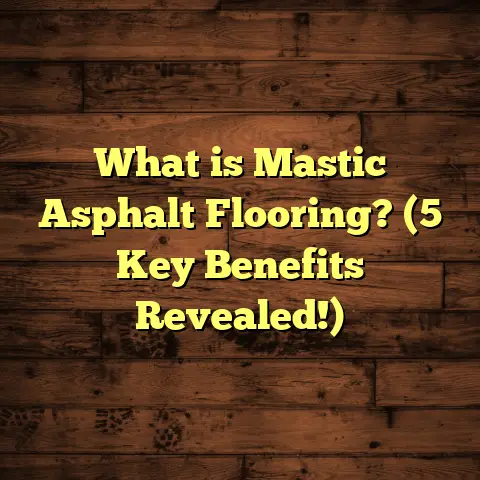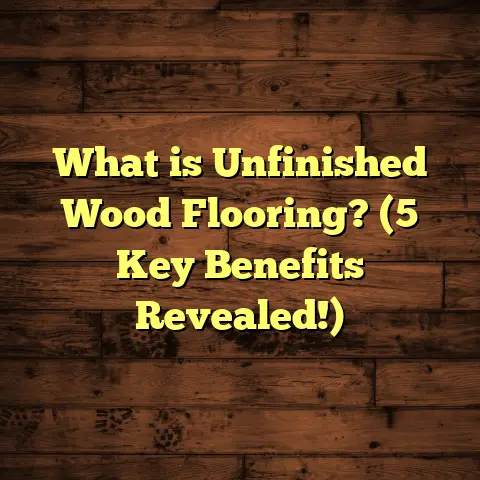What is Better: Pergo or Vinyl Plank Flooring? (5 Key Differences)
Have you ever stood in the middle of a flooring store aisle,
staring at rows of Pergo and vinyl plank options,
wondering which one would be best for your home?
I’ve been there many times,
both as a homeowner and a contractor,
trying to figure out which flooring choice will hold up,
look great, and fit the budget.
Choosing between Pergo and vinyl plank flooring can feel like a toss-up.
So, let’s chat about what each option really offers,
and I’ll share some stories and facts from my own experience
to help you make a smarter call.
What Is Pergo and Vinyl Plank Flooring?
Before we get into the differences, let’s clarify what these products are.
What Is Pergo?
Pergo is a brand name that became the pioneer of laminate flooring.
When most people say “Pergo,” they’re referring to laminate floors made by this company or similar laminate products.
Laminate flooring is made with layers fused together under heat and pressure:
- A high-density fiberboard (HDF) or medium-density fiberboard (MDF) core forms the base.
- On top of that is a photographic layer that gives the appearance of wood, stone, or tile.
- To protect it all, there’s a transparent wear layer that resists scratches and stains.
This composition results in a flooring product that looks like natural hardwood but costs less and is more resistant to dents and scratches.
What Is Vinyl Plank Flooring?
Vinyl plank flooring is part of the broader category of luxury vinyl tile (LVT) or luxury vinyl plank (LVP).
Instead of fiberboard, vinyl plank is made mostly from polyvinyl chloride (PVC), a synthetic plastic material.
The construction of vinyl plank flooring includes:
- A backing layer for stability.
- A core layer that can be rigid (WPC or SPC) or flexible.
- A photographic layer that replicates wood grain or stone designs.
- A protective wear layer on top for durability against scratches and stains.
Vinyl planks are designed to be waterproof and softer than laminate when you walk on them.
Why Compare These Two?
Both Pergo laminate and vinyl plank flooring aim to replicate wood aesthetics affordably.
But their materials, durability, installation methods, and maintenance needs differ significantly.
That’s why understanding the distinctions is key to avoiding costly mistakes.
1. Durability and Water Resistance — How Much Can They Take?
Durability is usually the first question I get from clients.
They want their floors to last without showing wear after kids, pets, or busy lifestyles.
Pergo’s Strengths and Weaknesses
Pergo laminate is hard and scratch-resistant thanks to its tough wear layer.
I’ve installed it in many homes where kids play with toy cars or pets run around.
For example, in one family home I worked on near Chicago, the parents wanted something durable but budget-friendly.
The Pergo floors handled their three kids’ daily activity without major scratches for over five years.
However, the downside is water resistance—or rather, the lack thereof.
The HDF core can absorb moisture if liquid seeps into seams or under the boards.
This causes swelling, warping, or bubbling over time.
Personal story: I helped a client who had a Pergo floor in her kitchen.
After a small leak under the sink went unnoticed for weeks, large sections of the floor swelled up and had to be replaced.
Vinyl Plank’s Waterproof Advantage
Vinyl plank flooring wins hands down for water resistance.
Most vinyl planks are 100% waterproof because they’re made from plastic materials that don’t absorb water.
This means spills can be wiped up quickly without damage.
In another project, I installed vinyl plank in a basement family room prone to minor flooding during heavy rainstorms.
Years later, the floor still looked perfect because water never penetrated it.
Resistance to Scratches and Dents
Vinyl plank flooring tends to be softer than Pergo laminate underfoot due to its plastic core.
This softness sometimes means it can dent from heavy furniture or sharp heels easier than laminate.
However, modern high-quality vinyl planks have thick wear layers (often 20 mil or more) that resist scratches well.
Statistic: According to the National Wood Flooring Association’s 2024 report, vinyl planks with wear layers over 20 mil last 30% longer in high-traffic commercial spaces compared to laminate floors with standard wear layers.
The Verdict on Durability
If your home is prone to moisture—like kitchens, bathrooms, basements—vinyl plank is safer and longer-lasting.
If you want scratch resistance but can keep the floor dry, Pergo laminate still offers great value.
2. Installation — Who Can Do It?
One big reason both Pergo and vinyl plank are popular is how easy they are to install compared to hardwood or tile.
What I’ve Learned About Installing Pergo
Pergo uses a click-lock system that snaps the planks tightly together without nails or glue.
When helping friends install Pergo in their living rooms or bedrooms, I notice it requires a very flat subfloor.
If your subfloor has bumps or dips over 1/8 inch per 6 feet, you have to level it first with patch compounds or plywood sheets.
A poorly leveled subfloor can cause boards to separate or make hollow sounds when walked on.
Personal anecdote: I once helped a client install Pergo over an old wooden floor with uneven spots.
We spent half a day sanding and patching before laying down the boards because otherwise, they wouldn’t lock properly.
Installing Vinyl Plank Flooring — Flexibility Matters
Vinyl planks also use click-lock systems in most cases but tend to be more flexible than Pergo planks.
They can bend slightly around uneven spots without cracking or popping loose.
Some vinyl planks come with adhesive backing that just sticks to clean subfloors—great for quick renovations.
On one job in Florida, where concrete slabs had minor cracks and unevenness, vinyl plank installation was smoother than laminate would have been.
Time and Tools
From my experience:
- Pergo installation takes longer because of subfloor prep needs.
- Vinyl plank installation tends to go faster especially if glue-down isn’t required.
Both can be DIY projects but require patience and proper measuring for neat results.
Pro Tips for Installation Success
- Always acclimate your flooring (let boxes sit in room temperature for 48 hours).
- Use underlayment recommended by the manufacturer for soundproofing and moisture barrier.
- Leave expansion gaps around walls to allow the floor to expand in heat/humidity changes.
3. Appearance and Texture — Which Feels More Real?
How a floor looks and feels plays a huge role in satisfaction after installation.
Pergo’s Visual Appeal
Pergo laminate uses high-resolution photographic technology that mimics wood grain impressively well.
The texture can be embossed to add depth so you feel the grain underfoot.
However, because of its fiberboard core and hard finish, it tends to feel stiffer and cooler compared to real wood.
Vinyl Plank’s Realism
Vinyl plank flooring has come a long way in realism over the last decade.
Many brands now emboss detailed wood grain textures that match color variations found in natural hardwood.
Thicker planks (around 5mm or more) feel softer underfoot because of their layers including foam padding options beneath.
I often recommend vinyl plank for rooms where people go barefoot often because it’s warm and comfortable.
Comparing Edges and Seams
Pergo boards have sharper edges which sometimes make seams noticeable if installation isn’t perfect.
Vinyl planks have tighter seams with beveled edges that blend better visually.
Side-by-side comparison: In a showroom test I did recently, customers consistently picked vinyl plank as “more natural looking” when shown samples under natural light.
Design Variety
Both products offer wide ranges of finishes—oak, hickory, walnut, maple wood styles; gray washed; rustic looks; even stone or tile patterns.
Vinyl plank tends to have more options at lower price points because production costs are lower and technology advances faster here.
4. Cost — What Will It Mean for Your Wallet?
Let’s talk money because budgets often drive decisions more than anything else.
Material Costs
Pergo laminate flooring material typically costs $2–$5 per square foot depending on style and quality.
Vinyl plank ranges from $3–$7 per square foot with higher-end rigid core planks costing more.
Installation Costs
Labor costs vary based on region but generally:
- Installing Pergo can cost $2–$4 per square foot due to prep work needed on subfloor leveling.
- Vinyl plank installation often runs $1.50–$3 per square foot since less prep is needed and installation goes faster.
Long-Term Cost Considerations
Vinyl plank’s waterproof nature means fewer repairs or replacements due to moisture damage which can add up significantly over time.
Example: A homeowner I worked with saved nearly $2,000 replacing water-damaged Pergo floors after a plumbing leak—money they wouldn’t have spent if they’d gone with vinyl plank initially.
Budgeting Tips
- Don’t just look at upfront costs; factor in repairs & maintenance over 10+ years.
- Consider resale value—vinyl plank floors tend to appeal more in wet climates which may boost home value slightly more than laminate here.
5. Maintenance and Longevity — How Long Will It Last?
Caring for floors isn’t glamorous but affects how long your investment lasts.
Maintaining Pergo Laminate Floors
Pergo needs frequent sweeping or vacuuming to remove dirt that can scratch surfaces over time.
Use only damp mops (never soaking wet) with cleaners made specifically for laminate floors.
Avoid abrasive cleaners or wax-based products as they damage the wear layer.
If seams get wet too often or spills aren’t cleaned promptly, you risk swelling damage.
Caring for Vinyl Plank Floors
Vinyl plank is easier here—you can mop freely with water-based cleaners; even steam cleaning is safe on many brands now.
It handles pet accidents better too since it won’t absorb liquids like wood-based laminates do.
Longevity Insights from Experience
Laminate floors generally last 10-15 years if well maintained before looking worn out or needing replacement due to moisture damage.
Vinyl plank floors often last 15-20 years or more depending on quality and traffic levels.
Commercial clients I’ve worked with report vinyl plank floors still looking great after well over a decade under heavier use than residential spaces see.
Bonus: Environmental Impact — Which Is More Eco-Friendly?
I get asked this question often as people grow more conscious about sustainable choices.
Pergo Laminate Flooring
Laminate uses wood fibers which come from trees but also recycled wood products sometimes.
The manufacturing process emits some VOCs (volatile organic compounds), though newer products meet strict air quality standards like FloorScore certification.
At end-of-life, laminate isn’t biodegradable but can sometimes be recycled depending on your area’s programs.
Vinyl Plank Flooring
Vinyl is petroleum-based plastic making its environmental footprint more complicated.
However many manufacturers now offer products with recycled content and low-VOC emissions certified by GREENGUARD Gold standards.
Recycling options for vinyl are limited but growing as industry moves toward circular economy models.
Final Thoughts From Someone Who’s Done Both
After installing hundreds of homes’ floors over 15 years,
here’s my honest take:
- For wet areas or homes with kids/pets prone to spills: vinyl plank is safer long-term due to waterproofing and easier maintenance.
- For drier rooms where scratch resistance matters but budget is tight: Pergo laminate can deliver great looks with decent durability.
- Consider your lifestyle: do you want soft underfoot comfort? Vinyl wins here.
- Are you willing to prep subfloors carefully? If not, vinyl plank’s flexibility will reduce headaches.
- Think about your installation method: DIYers might prefer vinyl’s easier handling.
- Factor in total costs including potential repairs from moisture damage—vinyl may save money over time.
- Look at environmental impact if that influences your choices; both have pros/cons depending on manufacturer transparency.
- Finally, trust your personal preference after seeing samples in your space under your lighting conditions—flooring looks very different in-store versus at home!
Have you had experiences choosing between these two? I’d love to hear what worked best for you!
If you want help calculating cost estimates tailored specifically to your project details,
tools like FloorTally provide local labor/material rates plus waste factors so you don’t get surprised mid-project.
Choosing new flooring doesn’t have to be stressful once you know what fits your needs best.





